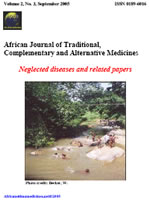
|
African Journal of Traditional, Complementary and Alternative Medicines
African Ethnomedicines Network
ISSN: 0189-6016
Vol. 13, No. 6, 2016, pp. 90-100
|
 Bioline Code: tc16146
Bioline Code: tc16146
Full paper language: English
Document type: Research Article
Document available free of charge
|
|
|
African Journal of Traditional, Complementary and Alternative Medicines, Vol. 13, No. 6, 2016, pp. 90-100
| en |
IMAGING OF BRAIN FUNCTION BASED ON THE ANALYSIS OF FUNCTIONAL CONNECTIVITY - IMAGING ANALYSIS OF BRAIN FUNCTION BY FMRI AFTER ACUPUNCTURE AT LR3 IN HEALTHY INDIVIDUALS
Zheng, Yu; Wang, Yuying; Lan, Yujun; Qu, Xiaodong; Lin, Kelin; Zhang, Jiping; Qu, Shanshan; Wang, Yanjie; Tang, Chunzhi & Huang, Yong
Abstract
Objective: This Study observed the relevant brain areas activated by acupuncture at the Taichong acupoint (LR3) and analyzed the
functional connectivity among brain areas using resting state functional magnetic resonance imaging (fMRI) to explore the acupoint
specificity of the Taichong acupoint.
Methods: A total of 45 healthy subjects were randomly divided into the Taichong (LR3) group, sham acupuncture group and sham
acupoint group. Subjects received resting state fMRI before acupuncture, after true (sham) acupuncture in each group. Analysis of
changes in connectivity among the brain areas was performed using the brain functional connectivity method.
Results: The right cerebrum temporal lobe was selected as the seed point to analyze the functional connectivity. It had a functional
connectivity with right cerebrum superior frontal gyrus, limbic lobe cingulate gyrus and left cerebrum inferior temporal gyrus (BA
37), inferior parietal lobule compared by before vs. after acupuncture at LR3, and right cerebrum sub-lobar insula and left cerebrum
middle frontal gyrus, medial frontal gyrus compared by true vs. sham acupuncture at LR3, and right cerebrum occipital lobe cuneus,
occipital lobe sub-gyral, parietal lobe precuneus and left cerebellum anterior lobe culmen by acupuncture at LR3 vs. sham acupoint.
Conclusion: Acupuncture at LR3 mainly specifically activated the brain functional network that participates in visual function,
associative function, and emotion cognition, which are similar to the features on LR3 in tradition Chinese medicine. These brain
areas constituted a neural network structure with specific functions that had specific reference values for the interpretation of the
acupoint specificity of the Taichong acupoint.
Keywords
acupuncture; Taichong(LR3); functional magnetic resonance imaging (fMRI); functional connectivity
|
| |
© Copyright 2016 - African Journal of Traditional, Complementary and Alternative Medicines
Alternative site location: http://journals.sfu.ca/africanem/index.php/ajtcam
|
|
